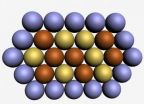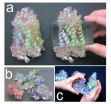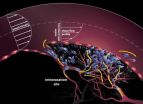(Press-News.org) Singapore, August 24, 2012 – Using a mixture of gold, copper and platinum nanoparticles, IBN researchers have developed a more powerful and longer lasting fuel cell material. This breakthrough was published recently in leading journal, Energy and Environmental Science.
Fuel cells are a promising technology for use as a source of electricity to power electronic devices, vehicles, military aircraft and equipment. A fuel cell converts the chemical energy from hydrogen (fuel) into electricity through a chemical reaction with oxygen. A fuel cell can produce electricity continuously as long as there is a fuel supply.
Current commercially available fuel cells use platinum nanoparticles as the catalyst to speed up the chemical reaction because platinum is the only metal that can resist the highly acidic conditions inside such a cell. However, the widespread use of fuel cells has been impeded by the high cost of platinum and its low stability.
To overcome this limitation, a team of researchers led by IBN Executive Director Professor Jackie Y. Ying has discovered that by replacing the central part of the catalyst with gold and copper alloy and leaving just the outer layer in platinum, the new hybrid material can provide 5 times higher activity and much greater stability than the commercial platinum catalyst. With further optimization, it would be possible to further increase the material's catalytic properties.
IBN's new nanocomposite material can produce at least 0.571 amperes of electric current per milligram of platinum, compared to 0.109 amperes per milligram of platinum for commercial platinum catalysts. This is also the first time that a catalyst has been shown to enhance both the stability and activity for the fuel cell reaction with a significantly reduced platinum content.
To make this catalyst more active than the commercial platinum catalyst, the researchers have designed the core of the nanocrsytalline material to be a gold-copper alloy, which has slightly smaller lattice spacing than the platinum coating on the nanocrystal's surface. This creates a compressive strain on the surface platinum atoms, making the platinum more active in the rate-limiting step of oxygen reduction reaction for the fuel cell. Replacing the core of the nanoparticle with the less expensive gold-copper alloy cuts down the usage of platinum, a highly expensive noble metal.
Professor Ying said, "A key research focus at IBN is to develop green energy technologies that can lead to greater efficiency and environmental sustainability. More active and less costly than conventional platinum catalysts, our new nanocomposite system has enabled us to significantly advance fuel cell development and make the technology more practical for industrial applications."
INFORMATION:
Reference:
1. J. Yang, X. Chen, X. Yang and J. Y. Ying, "Stabilization and Compressive Strain Effect of AuCu Core on Pt Shell for Oxygen Reduction Reaction," Energy and Environmental Science, (2012) DOI:10.1039/C2EE22172A.
About the Institute of Bioengineering and Nanotechnology
The Institute of Bioengineering and Nanotechnology (IBN) was established in 2003 and is spearheaded by its Executive Director, Professor Jackie Yi-Ru Ying.
Professor Ying was a Professor of Chemical Engineering at the Massachusetts Institute of Technology (1992 - 2005). She was recognized as one of "One Hundred Engineers of the Modern Era" by the American Institute of Chemical Engineers in 2008 for her groundbreaking work on nanostructured systems, nanoporous materials and host matrices for quantum dots and wires.
Under her direction, IBN conducts research at the cutting-edge of bioengineering and nanotechnology. Its programs are geared towards linking multiple disciplines across engineering, science and medicine to produce research breakthroughs that will improve healthcare and our quality of life.
IBN's research activities are focused in the following areas:
Drug and Gene Delivery, where the controlled release of therapeutics involve the use of functionalized polymers, hydrogels and biologics for targeting diseased cells and organs, and for responding to specific biological stimuli.
Cell and Tissue Engineering, where biomimicking materials, stem cell technology, microfluidic systems and bioimaging tools are combined to develop novel approaches to regenerative medicine and artificial organs.
Biodevices and Diagnostics, which involve nanotechnology and microfabricated platforms for high-throughput biomarker and drug screening, automated biologics synthesis, and rapid disease diagnosis.
Pharmaceuticals Synthesis and Green Chemistry, which encompasses the efficient catalytic synthesis of chiral pharmaceuticals, and new nanocomposite materials for sustainable technology and alternative energy generation.
IBN's innovative research is aimed at creating new knowledge and intellectual properties in the emerging fields of bioengineering and nanotechnology to attract top-notch researchers and business partners to Singapore. Since 2003, IBN researchers have published over 786 papers in leading journals.
IBN also plays an active role in technology transfer and spinning off companies, linking the research institute and industrial partners to other global institutions. The Institute has a portfolio of over 659 patents/patent applications on its inventions, and welcomes industrial and clinical partners to collaborate on and co-develop its technologies. IBN has successfully commercialized 33 patents/patent applications.
IBN's current staff and students strength stands at over 150 scientists, engineers and medical doctors. With its multinational and multidisciplinary research staff, the Institute is geared towards generating new biomaterials, devices, systems and processes to boost Singapore's economy in the medical technology, pharmaceuticals, chemicals, consumer products and clean technology sectors.
IBN is also committed to nurturing young talents. Besides the training of PhD students, IBN has a Youth Research Program (YRP) for students and teachers from secondary schools, junior colleges, polytechnics, and universities. Since its inception in October 2003, YRP has reached out to more than 58,800 students and teachers from 287 local and overseas schools and institutions. Over 1,600 students and teachers have completed research attachments at IBN for a minimum period of four weeks.
www.ibn.a-star.edu.sg
IBN develops superior fuel cell material
This technology can be used to power airplanes, vehicles and electronic devices
2012-08-24
ELSE PRESS RELEASES FROM THIS DATE:
Most mutations come from dad
2012-08-24
Humans inherit more than three times as many mutations from their fathers as from their mothers, and mutation rates increase with the father's age but not the mother's, researchers have found in the largest study of human genetic mutations to date.
The study, based on the DNA of around 85,000 Icelanders, also calculates the rate of human mutation at high resolution, providing estimates of when human ancestors diverged from nonhuman primates. It is one of two papers published this week by the journal Nature Genetics as well as one published at Nature that shed dramatic ...
Survival statistics show hard fight when malignant brain tumors appear at multiple sites
2012-08-24
LOS ANGELES (Embargoed until 10 a.m. EDT on Aug. 24, 2012) – When aggressive, malignant tumors appear in more than one location in the brain, patient survival tends to be significantly shorter than when the disease starts as a single tumor, even though patients in both groups undergo virtually identical treatments, according to research at Cedars-Sinai Medical Center's Maxine Dunitz Neurosurgical Research Institute.
"We've known that certain independent factors, such as age at diagnosis, amount of residual tumor after surgery, and the patient's functional status are useful ...
Bigger creatures live longer, travel farther for a reason
2012-08-24
DURHAM, N.C. -- A long-standing mystery in biology about the longer lifespans of bigger creatures may be explained by the application of a physical law called the Constructal Law (www.constructal.org).
What this law proposes is that anything that flows -- a river, bloodstream or highway network -- will evolve toward the same basic configuration out of a need to be more efficient. And, as it turns out, that same basic law applies to all bodies in motion, be they animals or tanker trucks, says Adrian Bejan, the J.A. Jones Professor of mechanical engineering at Duke and ...
New model gives hands-on help for learning the secrets of molecules
2012-08-24
For biology researchers, the complex world of molecular proteins – where tens of thousands of atoms can comprise a single protein – may be getting clearer with the help of a new soft, transparent, and squishy silicone model they can hold in their hands. Its advantage over traditional computer and solid models is that it is mostly transparent and easy to manipulate, which will help researchers more intuitively understand protein structures, positions, and interactions. The models will enable researchers to quickly and collaboratively see, touch, and test ideas about molecular ...
Modeling metastasis
2012-08-24
Cancer metastasis, the escape and spread of primary tumor cells, is a common cause of cancer-related deaths. But metastasis remains poorly understood. Studies indicate that when a primary tumor breaks through a blood vessel wall, blood's "stickiness" tears off tumor cells the way a piece of tape tears wrapping paper. Until now, no one knew the physical forces involved in this process, the first step in metastasis. Using a statistical technique employed by animators, scientists created a new computer simulation that reveals how cancer cells enter the bloodstream. The researchers ...
The end of an era? Branding horses does not enable them to be identified
2012-08-24
There are many reasons why it is important to be able to identify farm animals, horses and small companion animals. Unique identification marks are essential for ensuring the correctness of breeding programmes, for preventing the spread of disease and for eliminating the possibility of deceit in competitions or when animals are sold. The traditional method of marking larger farm animals relies on branding with hot irons or on ear-tagging but this is deemed inappropriate for use on dogs and cats, which are identified by the implant of a microchip transponder. Until recently, ...
Astrocytes control the generation of new neurons from neural stem cells
2012-08-24
Astrocytes are cells that have many functions in the central nervous system, such as the control of neuronal synapses, blood flow, or the brain's response to neurotrauma or stroke.
Reduces brain tissue damage
Prof. Pekny's laboratory together with collaborators have earlier demonstrated that astrocytes reduce the brain tissue damage after stroke and that the integration of transplanted neural stem cells can be largely improved by modulating the activity of astrocytes.
Generation of new neurons
In their current study, the Sahlgrenska Academy researchers show how astrocytes ...
Researchers describe new molecular interactions behind the inhibition of TGF beta-signaling
2012-08-24
This press release is available in Spanish.
Researchers headed by Maria Macias an ICREA researcher at the Institute for Research in Biomedicine (IRB Barcelona) and Joan Massagué, a Howard Hughes Medical Institute investigator at Memorial Sloan-Kettering Cancer Center (MSKCC) in New York, have identified a new molecular mechanism that plays a crucial role in the control of the activation of certain genes associated with cancer.
Through detailed structural and biochemical studies, the researchers identified a key domain present in a family of proteins called Smads, whose ...
Southampton physicists join search for hidden magnetic states
2012-08-24
Physicists from the University of Southampton were among the first researchers to use the new high magnetic-field beamline at Diamond Light Source, the UK's national synchrotron facility, to search for 'hidden magnetic states'.
If found, they will provide important confirmation of a theoretical model, which could have important applications in magnetic data storage.
Diamond's new I10 Beamline for Advanced Dichroism Experiments (BLADE) beamline, which has 300,000 times the strength of the earth's magnetic field, is providing them with the tools for the search. The beamline ...
Working class prefers comedy and the intellectual class goes for drama
2012-08-24
A study enjoying Spanish participation has analysed the theatre demand of society according to the socioeconomic status of the different types of the viewing public. The results were that the theatre is not just enjoyed by the intellectual classes. While they do prefer drama, the working class opts for comedy and the wealthier are swayed by reviews.
Theatre arts are loss-making services that require subsidies to stay afloat. This type of practice has frequently come under fire as it is thought that theatre is consumed mainly by society's economic elite.
A study published ...
LAST 30 PRESS RELEASES:
Low daily alcohol intake linked to 50% heightened mouth cancer risk in India
American Meteorological Society announces Rick Spinrad as 2026 President-Elect
Biomass-based carbon capture spotlighted in newly released global climate webinar recording
Illuminating invisible nano pollutants: advanced bioimaging tracks the full journey of emerging nanoscale contaminants in living systems
How does age affect recovery from spinal cord injury?
Novel AI tool offers prognosis for patients with head and neck cancer
Fathers’ microplastic exposure tied to their children’s metabolic problems
Research validates laboratory model for studying high-grade serous ovarian cancer
SIR 2026 delivers transformative breakthroughs in minimally invasive medicine to improve patient care
Stem Cell Reports most downloaded papers of 2025 highlight the breadth and impact of stem cell research
Oxford-led study estimates NHS spends around 3% of its primary and secondary care budget on the health impacts of heat and cold in England
A researcher’s long quest leads to a smart composite breakthrough
Urban wild bees act as “microbial sensors” of city health.
New study finds where you live affects recovery after a hip fracture
Forecasting the impact of fully automated vehicle adoption on US road traffic injuries
Alcohol-related hospitalizations from 2016 to 2022
Semaglutide and hospitalizations in patients with obesity and established cardiovascular disease
Researchers ‘listen in’ to embryo-mother interactions during implantation using a culture system replicating the womb lining
How changing your diet could help save the world
How to make AI truly scalable and reliable for real-time traffic assignment?
Beyond fragmented markets: A new framework for efficient and stable ride-pooling
Can shape priors make road perception more reliable for autonomous driving?
AI tracks nearly 100 years of aging research, revealing key trends and gaps
Innovative techniques enable Italy’s first imaging of individual trapped atoms
KIER successfully develops Korea-made “calibration thermoelectric module” for measuring thermoelectric device performance
Diversifying US Midwest farming for stability and resilience
Emphasizing immigrants’ deservingness shifts attitudes
Japanese eels, climate change, and river temperature
Pusan National University researchers discover faster, smarter heat treatment for lightweight magnesium metals
China’s 2024 Gastroenterology Report: marked progress in endoscopy quality and disease management
[Press-News.org] IBN develops superior fuel cell materialThis technology can be used to power airplanes, vehicles and electronic devices





